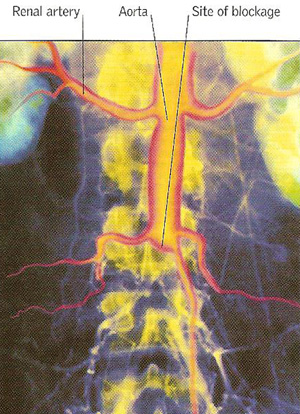thrombosis

Arterial thrombosis. This contrast X-ray shows blood flow in the aorta and adjacent arteries. A blood clot in the aorta is blocking the flow of blood below the site of the obstruction.
Thrombosis is the formation of a blood clot, known as a thrombus, in the heart or blood vessels. Clotting is a normal response to injury, but abnormal when a blood vessel has not been punctured.
A thrombus that forms within an artery supplying the heart muscle (coronary thrombosis) is the usual cause of myocardial infarction (heart attack). A thrombus in an artery of the brain (cerebral thrombosis) is a common cause of stroke).
Thrombi may block arteries supplying blood to the legs, kidneys, retinas, intestines, and other organs, sometimes causing severe damage and symptoms such as pain and loss of function. Thrombosis commonly occurs in the legs and is associated with varicose veins though this is not as serious as if it occurs in the heart or in the brain arteries. Detachments from a thrombus in the legs may be carried to the lungs as an embolus (see embolism; this may have a fatal outcome if large vessels are occluded.
Thrombi can also form in veins, either just beneath the skin or in deeper veins.
Causes
In the blood there is a fine balance between the mechanisms that encourage and discourage clotting, so there is neither a tendency to bleed nor to form clots (see blood clotting), Thrombosis can occur if this mechanism is disturbed in favor of clotting.
In arteries, thrombus formation is encouraged by atherosclerosis (a build-up of fatty deposits on the walls of arteries), smoking, high blood pressure (hypertension), and damage to blood vessel walls from inflammation in arteritis and phlebitis. An increased clotting tendency may occur in pregnancy, with the use or oral contraceptives.or through prolonged immobility.
Symptoms
An arterial thrombosis may cause no symptoms until the blood flow is impaired. When this occurs, it leads to reduced function in the tissue supplied by the affected artery, and sometimes severe pain. Venous thrombosis may cause pain and swelling.
Diagnosis and treatment
Diagnosis of thrombosis is by doppler ultrasound. In some cases angiography or venography may also be used. Treatment may include anticoagulant drugs or thrombolytic drugs, non-steroidal anti-inflammatory drugs, and, in some cases, antibiotics. In life-threatening cases, thrombectomy (surgical removal of the blood clot may be needed.


